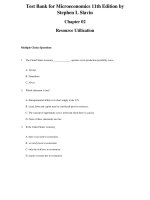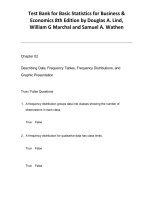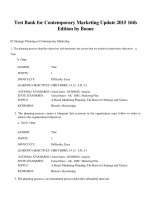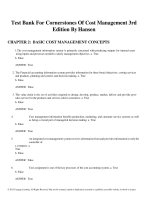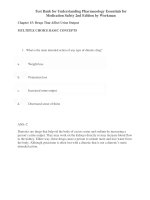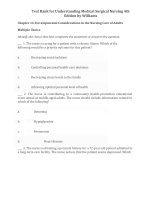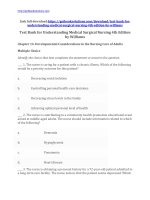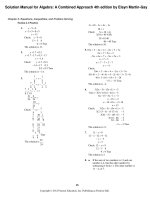link full download test bank for understanding medical surgical nursing 4th edition by williams
Bạn đang xem bản rút gọn của tài liệu. Xem và tải ngay bản đầy đủ của tài liệu tại đây (563.05 KB, 19 trang )
Test Bank for Understanding Medical Surgical Nursing 4th
Edition by Williams
Chapter 14. Developmental Considerations in the Nursing Care of Adults
Multiple Choice
Identify the choice that best completes the statement or answers the question.
____ 1. The nurse is caring for a patient with a chronic illness. Which of the
following would be a priority outcome for this patient?
a.
Decreasing social isolation
b.
Controlling personal health-care decisions
c.
Decreasing stress levels in the family
d.
Achieving optimal personal level of health
____ 2. The nurse is contributing to a community health-promotion educational
event aimed at middle-aged adults. The nurse should include information related to
which of the following?
a.
Dementia
b.
Hypoglycemia
c.
Pneumonia
d.
Heart disease
____ 3. The nurse is obtaining a personal history for a 72-year-old patient admitted to
a long-term care facility. The nurse notices that the patient seems depressed. Which
of the following interventions should the nurse recommend be included in
the patient’s plan of care?
a.
Tell the patient to look forward and not back at the
past.
b.
Guide the patient in reminiscing about the past with a
focus on the positives.
c.
Remind the patient to be accepting of help from family
members.
d.
Explain to the patient that some level of depression is
normal with aging.
____ 4. The nurse is caring for a patient who has a chronic illness and is depressed
over being a burden to others. Which nursing action would increase the selfesteem of this patient?
a.
Establishing long-term patient goals
b.
Performing activities of daily living for the patient
c.
Encouraging the family to provide supportive patient
care
d.
Allowing the patient self-care opportunities
____ 5. The nurse is caring for a patient who has a chronic illness. Which of the
following should the nurse encourage the patient to use as a coping resource?
a.
Be hopeful for a disease cure.
b.
Develop a realistic, hopeful attitude.
c.
Empower caregivers.
d.
Develop a power base.
____ 6. The nurse is caring for a 52-year-old patient who is self-absorbed. Which of
these does the nurse identify as likely causing this self-absorption?
a.
Unresolved finances
b.
Depression
c.
Unresolved generativity
d.
Loss of friends
____ 7. The nurse is contributing to a staff education program about
Erikson’s developmental stages.
Which of these would the nurse present as the developmental stage for an
older adult?
a.
Generativity versus self-absorption
b.
Identity versus role confusion
c.
Intimacy versus isolation
d.
Integrity versus despair
____ 8. The nurse is contributing to a staff education program about
Erikson’s developmental stages.
Which of these is the developmental stage for a middle-aged adult?
a.
Generativity versus self-absorption
b.
Identity versus role confusion
c.
Intimacy versus isolation
d.
Integrity versus despair
____ 9. The nurse is caring for a 21-year-old patient with a disfiguring injury.
Which of the following statements would the nurse expect related to the patient’s
developmental stage?
a.
“Soccer is my life, what if I can’t play anymore with my
friends?”
b.
“I just don’t know who I am now.”
c.
“I’m afraid my fiancé won’t want me anymore.”
d.
“I haven’t accomplished what I’d planned in life yet.”
____ 10. The nurse is contributing to the plan of care for a patient. What is the
most important role of the nurse in promoting health for a patient?
a.
Changing the patient’s habits
b.
Teaching healthful lifestyle practices
c.
Performing a health risk assessment
d.
Discussing poor health habits
____ 11. The nurse is contributing to a staff education program about health and
illness. How should the nurse characterize the relationship of health and illness?
a.
Exclusive concepts
b.
Nondynamic
c.
Changing states
d.
Constant states
____ 12. The nurse is caring for a patient who had a stroke that caused permanent
physical changes. Which of these developmental tasks does the nurse recognize
that the patient needs to accomplish for a positive outcome?
a.
Accepting that hope is gone
b.
Accepting that improvement is not possible
c.
Adapting to the changes
d.
Letting go of favorite hobbies
____ 13. The nurse would use which of these terms to describe a patient who
had satisfactorily fulfilled the developmental task for middle age?
a.
Creative
b.
Rebellious
c.
Self-centered
d.
Withdrawn
____ 14. The nurse would use which of these terms to describe a patient who
had unsatisfactorily fulfilled the developmental task for middle age?
a.
Creative
b.
Outgoing
c.
Productive
d.
Self-focused
____ 15. The nurse would use which of these terms to describe a patient who
had satisfactorily fulfilled the developmental task for old age?
a.
Accepting
b.
Productive
c.
Self-centered
d.
Withdrawn
____ 16. Which intervention would be appropriate for a middle-aged patient
who expresses, “I am afraid of being middle aged”?
a.
Explain to the patient that there is nothing to fear.
b.
Tell the patient that these are the best years of life.
c.
Reassure the patient that this fear is normal.
d.
Allow the patient to express fears.
____ 17. Which of these, if used to describe a patient, would the nurse determine
indicates a satisfactorily fulfilled developmental task of integrity?
a.
States a fear of death
b.
Accepts life lived
c.
Expresses dissatisfaction with life
d.
Grieves over life mistakes
Multiple Response
Identify one or more choices that best complete the statement or answer the question.
____ 18. The nurse is contributing to a staff education program about chronic
illness. Which of the following are reasons for the increasing incidence of chronic
illness? (Select all that apply.)
a.
People are living longer.
b.
There is an increase in the number of hospitals.
c.
Fewer people are dying from acute illnesses.
d.
Medical advances reduced mortality from chronic
illnesses.
e.
More people have an active lifestyle.
f.
The birth rate is increasing rapidly.
____ 19. The nurse is contributing to a staff education program about adult health
concerns. Which of the following are common health concerns of middle-aged
adults? (Select all that apply.)
a.
Alzheimer’s disease
b.
Cardiovascular disease
c.
Hypertension
d.
e.
f.
Kidney failure
Stroke
Visual changes
____ 20. The nurse is contributing to a staff education program about chronic
illness. Which of the following are acquired (not congenital or genetic) chronic
illnesses? (Select all that apply.)
a.
Cataracts
b.
Chronic obstructive pulmonary disease
c.
Cancer
d.
Huntington’s disease
e.
Muscular dystrophy
f.
Multiple sclerosis
____ 21. The nurse is contributing to a staff education program about chronic
illness. Which of the following is a congenital disease? (Select all that apply.)
a.
Cancer
b.
Cystic fibrosis
c.
Huntington’s disease
d.
Malabsorption syndrome
e.
Sickle cell anemia
f.
Spina bifida
____ 22. The nurse is reinforcing teaching for a chronically ill older patient to assist
the patient in adapting to a chronic illness. Which of the following should the
nurse include in the teaching? (Select all that apply.)
a.
Try to ignore your symptoms as much as possible.
b.
Revise your daily schedule as needed to adjust to your
illness.
c.
Understand your medical regimen, and follow it
carefully.
d.
Limit your social contacts and activities.
e.
Plan ways to compensate for your limitations.
____ 23. Which of these characteristics would the nurse recognize as being
displayed by a patient exhibiting despair? (Select all that apply.)
a.
Coping with aging changes
b.
Stating a fear of death
c.
Finding meaning in life
d.
Expressing life satisfaction
e.
Avoiding social activities
f.
Exercising daily
____ 24. The nurse is caring for a patient who has been working on issues related to
the developmental stage of young adulthood. Which of the following, if documented
about the patient, would indicate to the nurse resolutions of the developmental
task issues? (Select all that apply.)
a.
Has large network of family and friends at bedside
b.
Verbalizes sense of productivity at work
c.
Expresses concern for future generations
d.
Verbalizes acceptance of life decisions
e.
Expresses concern illness will cause strain on spouse
and children
f.
Requests visit from chaplain to discuss multiple losses
and sense of isolation
____ 25. The nurse is assisting in the care of a patient with small cell lung cancer who
regrets a long-term history of smoking and verbalizes a desire to stop smoking.
Which of the following interventions would the nurse recommend be included in
the patient’s plan of care? (Select all that apply.)
a.
Provide information related to smoking cessation.
b.
Encourage the patient to establish short-term goals.
c.
Discuss the patient’s previous efforts to stop smoking.
d.
Inform the patient that smoking cessation at this point
is not beneficial.
e.
Refer the patient for electroshock therapy.
f.
Discuss the benefits of smoking cessation with the
patient and family.
____ 26. The nurse is caring for a patient who has a chronic illness and whose
spouse is the caregiver. Which of the following should the nurse do to assist the
caregiver with coping? (Select all that apply.)
a.
Convey that a cure is possible.
b.
Encourage a realistic, hopeful attitude.
c.
Empower the caregiver.
d.
Assist the caregiver in identifying a support network.
e.
Share community resources.
____ 27. The nurse is contributing to the plan of care for a patient who has a
chronic illness and has a caregiver. What does the nurse understand are the
purposes of respite care? (Select all that apply.)
a.
Provide the caregiver with a vacation.
b.
Allow the caregiver to reduce stress.
c.
Evaluate the health of the patient.
d.
Allow the caregiver to go shopping.
e.
Prevent patient neglect.
Chapter 14. Developmental Considerations in the Nursing Care of Adults
Answer Section
MULTIPLE CHOICE
1.ANS:D
The goal of nursing care for any patient, including a patient with chronic illness,
can best be defined as helping a patient achieve his or her highest possible level of
wellness.
PTS:1DIF:EasyREF:Page 256
KEY: Client Need: Health Promotion and Maintenance | Cognitive Level: Application
| Integrated Processes: Clinical Problem-Solving Process | Question to Guide Your
Learning: 5
2.ANS:D
Hypertension and heart disease are major health concerns for middle-aged
adult Americans.
PTS:1DIF:EasyREF:Page 258
KEY: Client Need: Health Promotion and Maintenance | Cognitive Level: Application
| Integrated Processes: Clinical Problem-Solving Process | Question to Guide Your
Learning: 4
3.ANS:B
The developmental goal for people age 65 or older is integrity versus despair.
Reminiscence is one way for the nurse to assist the older adult in passing
through this stage. Depression is not normal with aging.
PTS:1DIF:HardREF:Page 258
KEY: Client Need: Psychosocial Integrity | Cognitive Level: Application | Integrated
Processes: Clinical Problem-Solving Process | Question to Guide Your Learning: 1
4.ANS:D
Establishing short-term goals or self-care activities that allow patients to participate
or have small successes are important nursing actions that can increase their selfesteem.
PTS:1DIF:EasyREF:Page 261
KEY: Client Need: Psychosocial Integrity | Cognitive Level: Application | Integrated
Processes: Caring | Question to Guide Your Learning: 5
5.ANS:B
Before coping resources can be used, hope must be established by the patient. False
hope is not beneficial and should be replaced with realistic hope. Providing
patients with accurate knowledge regarding their fears helps do this. Hope should
not be directed toward a cure that may not be possible, but rather at living a quality
life with the functional capacity that the patient has.
PTS:1DIF:MediumREF:Page 262
KEY: Client Need: Psychosocial Integrity | Cognitive Level: Application | Integrated
Processes: Clinical Problem-Solving Process | Question to Guide Your Learning: 5
6.ANS:C
The psychological developmental task of this age group is developing
generativity versus self-absorption. Unresolved conflict could be seen as
preoccupation with personal needs or self-absorption.
PTS:1DIF:EasyREF:Page 257
KEY: Client Need: Psychosocial Integrity | Cognitive Level: Application | Integrated
Processes: Clinical Problem-Solving Process | Question to Guide Your Learning: 1
7.ANS:D
The developmental goal for people age 65 or older is integrity versus despair. The
older adult looks back and evaluates what has been done with his or her life.
Integrity refers to accepting responsibility for one’s life so far and reflecting on it
in a positive way.
PTS:1DIF:EasyREF:Page 257
KEY:Client Need: Psychosocial Integrity | Cognitive Level: Recall | Integrated
Processes: Teaching and Learning | Question to Guide Your Learning:
1 8.ANS:A
During ages 45 to 65, the psychological developmental task of this age group is
developing generativity versus self-absorption. Generativity includes a sense of
productivity and creativity and is demonstrated by a concern and support for
others, along with a vision for future generations. Unresolved conflict could be
seen as preoccupation with personal needs or self-absorption.
PTS:1DIF:EasyREF:Page 257
KEY:Client Need: Psychosocial Integrity | Cognitive Level: Recall | Integrated
Processes: Teaching and Learning | Question to Guide Your Learning: 1
9.ANS:C
Intimacy versus isolation is the young adult’s task, which is to develop
relationships. This is likely to be threatened during illness and is most likely to be
the highest priority for the patient. A represents industry versus inferiority, a
developmental stage of childhood. B represents identity versus role confusion, a
developmental stage of childhood. D represents generativity versus self-absorption,
a developmental stage of a middle-aged adult.
PTS:1DIF:HardREF:Page 257
KEY: Client Need: Psychosocial Integrity | Cognitive Level: Application | Integrated
Processes: Caring | Question to Guide Your Learning:
1 10.ANS:B
Teaching educates and empowers others to perform actions to maintain their
own health.
PTS:1DIF:EasyREF:Page 257
KEY:Client Need: Health Promotion and Maintenance | Cognitive Level: Application |
Integrated Processes: Teaching and Learning | Question to Guide Your Learning:
4 11.ANS:C
Rather than being exclusive concepts, health and illness are dynamic and everchanging states of being.
PTS:1DIF:EasyREF:Page 256
KEY:Client Need: Health Promotion and Maintenance | Cognitive Level:
Comprehension | Integrated Processes: Teaching and Learning | Question to Guide
Your Learning: 2
12.ANS:C
Coping with a chronic illness can be aided if the patient develops a positive
attitude toward the illness. This can be accomplished if the patient gains
knowledge, uses a problem-solving approach to difficulties, and becomes
motivated to continue adapting to the illness.
PTS:1DIF:MediumREF:Page 258
KEY: Client Need: Psychosocial Integrity | Cognitive Level: Analysis | Integrated
Processes: Clinical Problem-Solving Process | Question to Guide Your Learning: 1
13.ANS:A
The psychological developmental task of this age group is developing generativity
versus self-absorption. Generativity includes a sense of productivity and creativity.
PTS:1DIF:MediumREF:Page 257
KEY: Client Need: Psychosocial Integrity | Cognitive Level: Application | Integrated
Processes: Communication and Documentation | Question to Guide Your Learning:
1 14.ANS:D
The psychological developmental task of this age group is developing
generativity versus self-absorption. Unresolved conflict could be seen as
preoccupation with personal needs or being self-focused.
PTS:1DIF:MediumREF:Page 257
KEY: Client Need: Psychosocial Integrity | Cognitive Level: Application | Integrated
Processes: Communication and Documentation | Question to Guide Your Learning:
1 15.ANS:A
The developmental goal for older adults is integrity versus despair. Integrity
refers to accepting responsibility for one’s life so far.
PTS:1DIF:MediumREF:Page 258
KEY: Client Need: Psychosocial Integrity | Cognitive Level: Application | Integrated
Processes: Communication and Documentation | Question to Guide Your Learning:
1 16.ANS:D
As a first step in therapeutic communication, it is important to allow patients to
express concerns whenever they express them. Then based on what is expressed, care
can be planned. False reassurance and subjective opinions are not therapeutic.
PTS:1DIF:MediumREF:Page 257
KEY: Client Need: Psychosocial Integrity | Cognitive Level: Application | Integrated
Processes: Communication and Documentation | Question to Guide Your Learning: 1
17.ANS:B
The developmental goal for older adults is integrity versus despair. Integrity
refers to accepting responsibility for one’s life so far.
PTS:1DIF:MediumREF:Page 258
KEY: Client Need: Psychosocial Integrity | Cognitive Level: Application | Integrated
Processes: Communication and Documentation | Question to Guide Your Learning: 1
MULTIPLE RESPONSE
18.ANS:A, C, D, E
Chronic illness is rising because people are living longer, due in part to more active
lifestyles. Fewer people are dying from acute diseases. Medical advances have
resulted in reduced mortality from some chronic illnesses. Birth rate has been
relatively stable over the past few years and lower than it was in the 1930s; birth
rate does not directly affect the incidence of chronic illnesses that primarily occur
in older individuals.
PTS:1DIF:EasyREF:Page 258
KEY: Client Need: Health Promotion and Maintenance | Cognitive Level: Recall |
Integrated Processes: Teaching and Learning | Question to Guide Your Learning:
2 19.ANS:B, C, F
Middle-aged adults are those ages 45 to 65 years. Visual changes, hypertension, and
heart disease are major health concerns of middle age. Kidney disease, stroke, and
Alzheimer’s disease typically occur in older adults.
PTS:1DIF:EasyREF:Page 257
KEY: Client Need: Health Promotion and Maintenance | Cognitive Level: Recall |
Integrated Processes: Teaching and Learning | Question to Guide Your Learning: 1
20.ANS:A, B, C, F
A, B, C, E, D, and F are genetic disorders.
PTS:1DIF:EasyREF:Page 261
KEY:Client Need: PHYS—Physiological Adaptation | Cognitive Level: Comprehension
| Integrated Processes: Teaching and Learning | Question to Guide Your Learning: 2
21.ANS:D, F
D, F. Malabsorption syndrome and spina bifida are congenital diseases. A, B, C, and
E are genetic disorders. Cancer is an acquired disease.
PTS:1DIF:EasyREF:Page 261
KEY:Client Need: PHYS—Physiological Adaptation | Cognitive Level: Comprehension
| Integrated Processes: Teaching and Learning | Question to Guide Your Learning:
2 22.ANS:B, C, E
B. Appointments and rest periods, for example, must be considered in the patient’s
schedule. C. To prevent complications, it is essential to understand the medical
regimen. E. Planning for methods to adapt to limitations is very helpful for
successful adaptation. A. Symptoms should not be ignored to prevent
complications. D. To prevent isolation, maintain social contacts and activities.
PTS:1DIF:HardREF:Page 261
KEY: Client Need: PHYS—Physiological Adaptation | Cognitive Level: Application |
Integrated Processes: Teaching and Learning | Question to Guide Your Learning:
5 23.ANS:B, E
An indication of unsuccessful completion of prior developmental stages results in
feelings of despair that life has been lived in vain and a fear of death. Socializing
and exercise are indicative of positive adjustments and an active and productive
lifestyle.
PTS:1DIF:EasyREF:Page 263
KEY: Client Need: Psychosocial Integrity | Cognitive Level: Analysis | Integrated
Processes: Clinical Problem-Solving Process | Question to Guide Your Learning: 1
24.ANS:A, E
A and E. Developing intimacy versus isolation is the sixth psychological
developmental stage. The young adult’s task is to develop relationships with a
spouse, family, or friends which are warm, affectionate, and developed through
fondness, understanding, caring, or love. F. When this stage is not successfully
resolved, the individual often experiences isolation from others. B and C. In the
middle adult years, the psychological developmental stage is developing
generativity versus self-absorption. Generativity includes a sense of productivity
and creativity and is demonstrated by a concern and support for others, along with
a vision for future generations. D. The developmental stage for older adults is
integrity versus despair. In this stage, the older adult looks back and evaluates
what has been done with his or her life. Integrity refers to accepting responsibility
for one’s life so far and reflecting on it in a positive way.
PTS:1DIF:HardREF:Page 257
KEY: Client Need: Psychosocial Integrity | Cognitive Level: Analysis | Integrated
Processes: Communication and Documentation | Question to Guide Your Learning:
1 25.ANS:A, B, C, F
The patient with chronic lung disease who smokes can make a choice to smoke or to
quit smoking. Providing patients with knowledge to make informed decisions
empowers them to take control of their lives and reach for their greatest potential.
Establishing short-term goals or self-care activities that allow them to participate or
have small successes are important nursing actions that can increase self-esteem.
Assessment of previous attempts to stop smoking is an important part of assisting
the patient to choose effective health promotion strategies. D. Health promotion is
possible and necessary at all levels of age or disability. E. Electroshock therapy is not
used to promote smoking cessation.
PTS:1DIF:MediumREF:Page 266
KEY: Client Need: Psychosocial Integrity | Cognitive Level: Application | Integrated
Processes: Caring | Question to Guide Your Learning: 4| Question to Guide Your
Learning: 5
26.ANS:B, C, D, E
All but A offer the caregiver encouragement and methods for coping as a caregiver.
PTS:1DIF:HardREF:Page 265
KEY: Client Need: Psychosocial Integrity | Cognitive Level: Application | Integrated
Processes: Caring | Question to Guide Your Learning:
3 27.ANS:A, B, D, E
All but C either offer the caregiver personal time to be alone and destress or perform
activities such as shopping to cope as a caregiver. Caregivers who are too
stressed by the caregiver role may become neglectful which can be a form of
patient abuse, although they do not intentionally mean to abuse the patient. Rather,
they have become overwhelmed with their caregiver role.
PTS:1DIF:MediumREF:Page 265
KEY: Client Need: Psychosocial Integrity | Cognitive Level: Application | Integrated
Processes: Caring | Question to Guide Your Learning: 3
